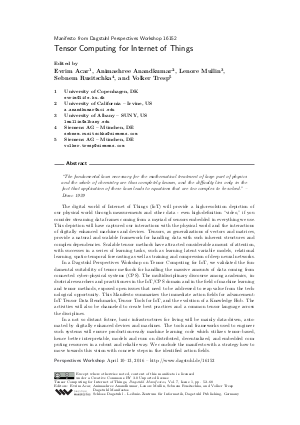Tensor Computing for Internet of Things (Dagstuhl Perspectives Workshop 16152)
Authors Evrim Acar, Animashree Anandkumar, Lenore Mullin, Sebnem Rusitschka, Volker Tresp
-
Part of:
Issue:
Dagstuhl Manifestos, Volume 7, Issue 1
Part of: Volume: Dagstuhl Manifestos, Volume 7
Part of: Journal: Dagstuhl Manifestos (DagMan) - License:
 Creative Commons Attribution 3.0 Unported license
Creative Commons Attribution 3.0 Unported license
- Publication Date: 2018-05-29
File

PDF
DagMan.7.1.52.pdf
- Filesize: 0.69 MB
- 17 pages
Document Identifiers
Subject Classification
Keywords
- Distributed Systems
- Real-time and embedded systems
- Signal processing systems
- Learning
- Multiagent systems
Metrics
- Access Statistics
-
Total Accesses (updated on a weekly basis)
0Document
0Metadata
Abstract
"The fundamental laws necessary for the mathematical treatment of large part of physics and the whole of chemistry are thus completely known, and the difficulty lies only in the fact that application of these laws leads to equations that are too complex to be solved." - Dirac 1929 The digital world of Internet of Things (IoT) will provide a high-resolution depiction of our physical world through measurements and other data - even high-definition "video," if you consider streaming data frames coming from a myriad of sensors embedded in everything we use. This depiction will have captured our interactions with the physical world and the interactions of digitally enhanced machines and devices. Tensors, as generalizations of vectors and matrices, provide a natural and scalable framework for handling data with such inherent structures and complex dependencies. Scalable tensor methods have attracted considerable amount of attention, with successes in a series of learning tasks, such as learning latent variable models, relational learning, spatio-temporal forecasting as well as training [19] and compression [20] of deep neural networks. In a Dagstuhl Perspectives Workshop on Tensor Computing for IoT, we validated the fundamental suitability of tensor methods for handling the massive amounts of data coming from connected cyber-physical systems (CPS). The multidisciplinary discourse among academics, industrial researchers and practitioners in the IoT/CPS domain and in the field of machine learning and tensor methods, exposed open issues that need to be addressed to reap value from the technological opportunity. This Manifesto summarizes the immediate action fields for advancement: IoT Tensor Data Benchmarks, Tensor Tools for IoT, and the evolution of a Knowledge Hub. The activities will also be channeled to create best practices and a common tensor language across the disciplines. In a not so distant future, basic infrastructures for living will be mainly data-driven, automated by digitally enhanced devices and machines. The tools and frameworks used to engineer such systems will ensure production-ready machine learning code which utilizes tensor-based, hence better interpretable, models and runs on distributed, decentralized, and embedded computing resources in a robust and reliable way. We conclude the manifesto with a strategy how to move towards this vision with concrete steps in the identified action fields.
Cite As Get BibTex
Evrim Acar, Animashree Anandkumar, Lenore Mullin, Sebnem Rusitschka, and Volker Tresp. Tensor Computing for Internet of Things (Dagstuhl Perspectives Workshop 16152). In Dagstuhl Manifestos, Volume 7, Issue 1, pp. 52-68, Schloss Dagstuhl – Leibniz-Zentrum für Informatik (2018)
https://doi.org/10.4230/DagMan.7.1.52
BibTex
@Article{acar_et_al:DagMan.7.1.52,
author = {Acar, Evrim and Anandkumar, Animashree and Mullin, Lenore and Rusitschka, Sebnem and Tresp, Volker},
title = {{Tensor Computing for Internet of Things (Dagstuhl Perspectives Workshop 16152)}},
pages = {52--68},
journal = {Dagstuhl Manifestos},
ISSN = {2193-2433},
year = {2018},
volume = {7},
number = {1},
editor = {Acar, Evrim and Anandkumar, Animashree and Mullin, Lenore and Rusitschka, Sebnem and Tresp, Volker},
publisher = {Schloss Dagstuhl -- Leibniz-Zentrum f{\"u}r Informatik},
address = {Dagstuhl, Germany},
URL = {https://drops.dagstuhl.de/entities/document/10.4230/DagMan.7.1.52},
URN = {urn:nbn:de:0030-drops-88244},
doi = {10.4230/DagMan.7.1.52},
annote = {Keywords: Distributed Systems, Real-time and embedded systems, Signal processing systems, Learning, Multiagent systems}
}
